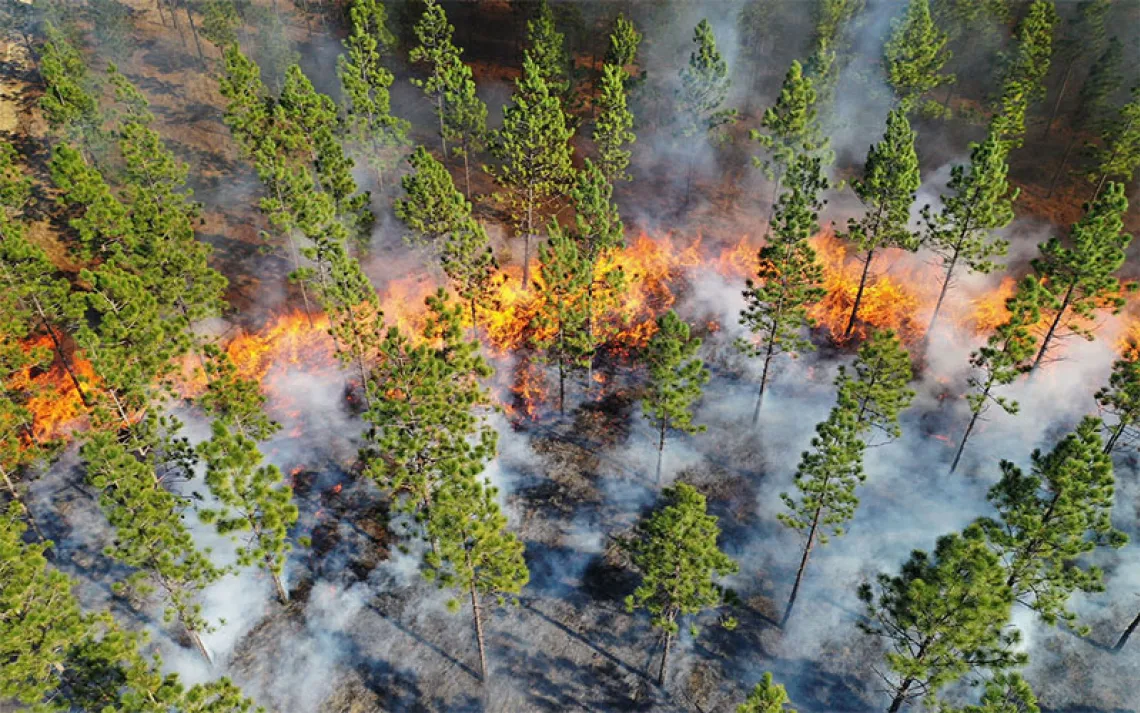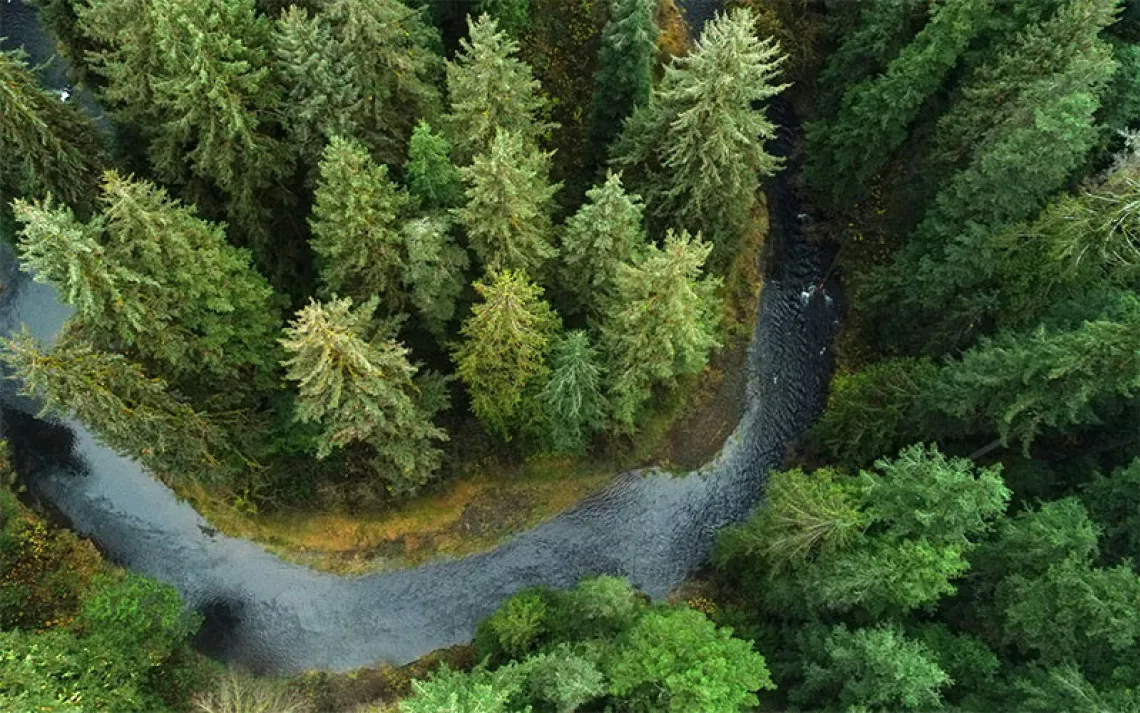Can a Better Understanding of Fungi Help Restore Northeastern Forests?
Why we should respect soil as a living organism

Ectomycorrhizal fungi are symbionts with most forest trees. They live in the forest soil and associate with plants' roots. In the mutualistic extreme of this symbiosis, fungi give nutrients and water to the plant in exchange of photosynthetic plant carbon. | Photo courtesy of Nahuel Policelli (postdoctoral associate, Boston University)
In the northeastern United States, deciduous hardwood forests have been experiencing declines for decades. A new study from Clark University and the Nature Conservancy, for example, found that New York and New England have been losing a combined average of 23,500 acres of forest a year to development, agriculture, and other land uses. Even in the remaining smaller, fragmented tracts of trees, though, change is afoot. It can come from blights like beech bark disease or pests like the emerald ash borer, which can weaken trees or kill some of them outright. Or, the changes can be subtler, with various species starting to thrive in some places while others become supplanted.
Some of this is just the way in which what’s called succession, or the natural replacement of plant and animal species over time, works in forests. Some of it is attributable to climate change, in which warming temperatures are altering what species grow and thrive in certain regions. Why and how change is happening, and what the implications could be for people seeking to conserve or restore forested land, are questions that Nahuel Policelli and Corinne Vietorisz, researchers in the Bhatnagar Lab of Microbial Ecology at Boston University, have been looking to answer. Their interest, though, lies less in what’s happening aboveground with the trees themselves (a departure from conservationists’ traditional concern, which, according to Policelli, has the potential to result in conservation failures) and more in the role of fungal communities, located belowground in soil and attached to tree roots, in forests’ changes.
“Fungi in general have been overlooked along with other soil microbes,” says Policelli. “They are tiny and difficult to study, but in the last 20 years we have the technology to identify them and which processes they’re involved in.”
Policelli and Vietorisz recently embarked on a new project to examine the soil in urban forests in Massachusetts, to see if they could figure out how fungi living in soil as well as ectomycorrhizal fungi—that is, fungi that attach to tree roots and allow them to better access nutrients and water in exchange for sugar—might be assisting pine trees in encroaching into predominantly oak and other hardwood forests.
“Pine trees have been cut multiple times since the British colonization, to build ships, and they always come back; this is the fourth or fifth time these forests have regenerated this way,” says Policelli. “Our work is a little piece of the puzzle of pine encroachment [and] how forests are shifting. How do [microbes like fungi] change soil, and what will happen to carbon, nitrogen, and phosphorous [in the soil] as pines move in and forests change?”

Photo courtesy of Katherine Sotiropoulou (undergrad student, Boston University)
To find out what’s going on down there, over the course of several humid weeks this past summer and early fall, Policelli led a small team out into six local fragmented forests: three sites in Harvard Forest in Petersham; Hammond Woods in Newton; Landlocked Forest in Burlington; and Whipple Hill in Lexington. Each of these spots, on which the team will conduct soil and root comparisons, contain four types of forest: mature pine, mature hardwood, hardwood with young pines encroaching, and mixed forest featuring both mature hardwood and mature pines. One overarching question the team hopes to answer: Which ones have the greatest fungal species diversity, and how might that be affecting the diversity of trees growing there?
Plunging a sterilized knife into the dirt, the team collected soil “brownies” at various forest intervals, starting with the city-abutting edge and then moving farther into the forest’s interior, as fungal and other microbial communities are known to differ along this gradient, according to Vietorisz. They also took soil core samples to check root density, and to determine which kinds of ectomycorrhizal fungi are pairing with different tree species. Analyzing DNA and RNA extracted from their samples will additionally allow Policelli and Vietorisz to identify which fungi are associated with which trees and to figure out how the fungi are interacting with their host trees and impacting carbon, nitrogen, and phosphorous in the soil.
At the moment, “It is unknown how the changes in fungal communities with [pine encroachment] relate to the changes in soil nutrients, and if there are key fungal species that may be drivers of soil nutrient changes,” explained Vietorisz by email. “We care about this because soil nutrient changes could affect the health of native forests, soil carbon storage, decomposition, and lots of other things. Or, if ectomycorrhizae and pines are preferentially [encroaching on] areas with specific soil nutrient conditions, that could help predict where pines may [encroach]” and perhaps allow for interventions before things get too serious.
What is known, though, is that pines can have a strong propensity for taking over. In the Global South, pine trees were planted for timber beginning in the early 20th century. A lot of these plantations were abandoned starting in the 1950s, whereafter some trees started to invade native areas, says Policelli, taking over grasslands and turning mixed forests into monospecific ones—until researchers realized the trees were being helped along by ectomycorrhizal fungi and were thus able to change the way they managed the invasions.
“Before, they were investing tons of money to get rid of pines, but now we understand that to control pines and restore areas, we need to consider the belowground aspect,” Policelli says. And although there are differences in the ways non-native pine trees invade in places like Argentina and New Zealand, and the way native pine trees encroach in New England, the way the ectomycorrhizal partnership works between the trees and fungi is the same. Another question for the researchers is whether understanding the underground functioning of one will shed understanding into the underground functioning of the other.
Above all, though, what Policelli hopes materializes from his and other research around these fungal relationships is that forest conservationists will start to think more holistically about what goes on in the soil—and how that affects what goes on above it. “Stop considering soil as the recipient—this black box we put nutrients like nitrogen into,” he says, “and start thinking of it as a living organism.”
 The Magazine of The Sierra Club
The Magazine of The Sierra Club



